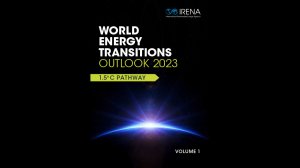- World Energy Transitions Outlook 2023: 1.5°C Pathway6.24 MB
With the world still reeling from the economic effects of the pandemic, the scale of the climate emergency has become ever more obvious in recent years, with record high temperatures and extreme weather events linked to climate change occurring around the globe.
The success achieved this decade in reducing greenhouse gas emissions will determine whether global temperature rise can be limited to 1.5°C of pre-industrial levels this century, in line with the objectives of the Paris Agreement. IRENA’s 1.5°C Scenario, set out in the World Energy Transitions Outlook, presents a pathway to achieve the 1.5°C target by 2050, positioning electrification and efficiency as key transition drivers, enabled by renewable energy, clean hydrogen and sustainable biomass.
This first volume of the 2023 Outlook provides an overview of progress by tracking implementation and gaps across all energy sectors, and identifies priority areas and actions based on available technologies that must be realised by 2030 to achieve net zero emissions by mid-century.
The report also provides three key pillars that can form the foundations for action to realign the global energy transition with climate objectives: building the necessary infrastructure and investing at scale to accommodate new production locations, trade patterns and demand centres; advancing a policy and regulatory architecture that can facilitate targeted investments, and improve socio-economic and environmental outcomes; and a strategic realignment of institutional capacities to help ensure that skills and capabilities match an energy system that integrates a high share of renewables.
Report by the International Renewable Energy Agency
EMAIL THIS ARTICLE SAVE THIS ARTICLE ARTICLE ENQUIRY
To subscribe email subscriptions@creamermedia.co.za or click here
To advertise email advertising@creamermedia.co.za or click here











